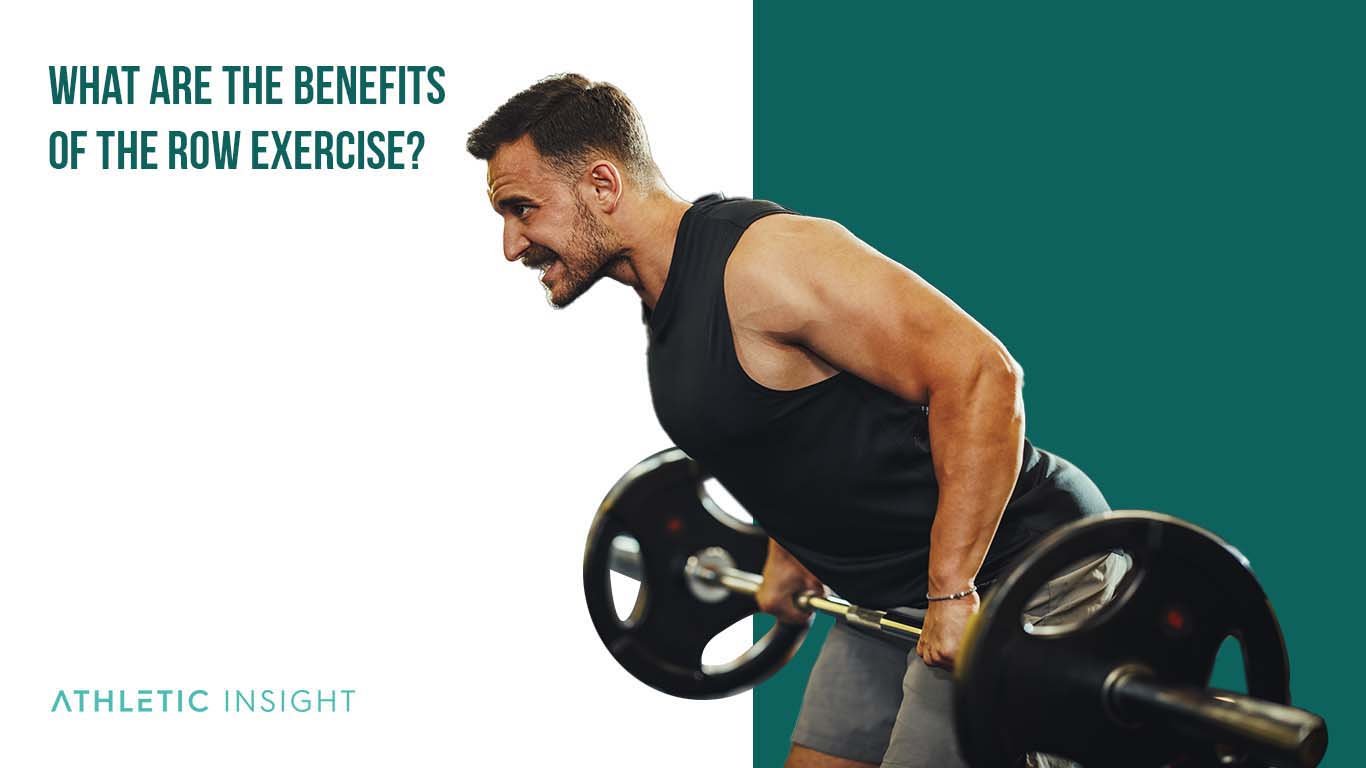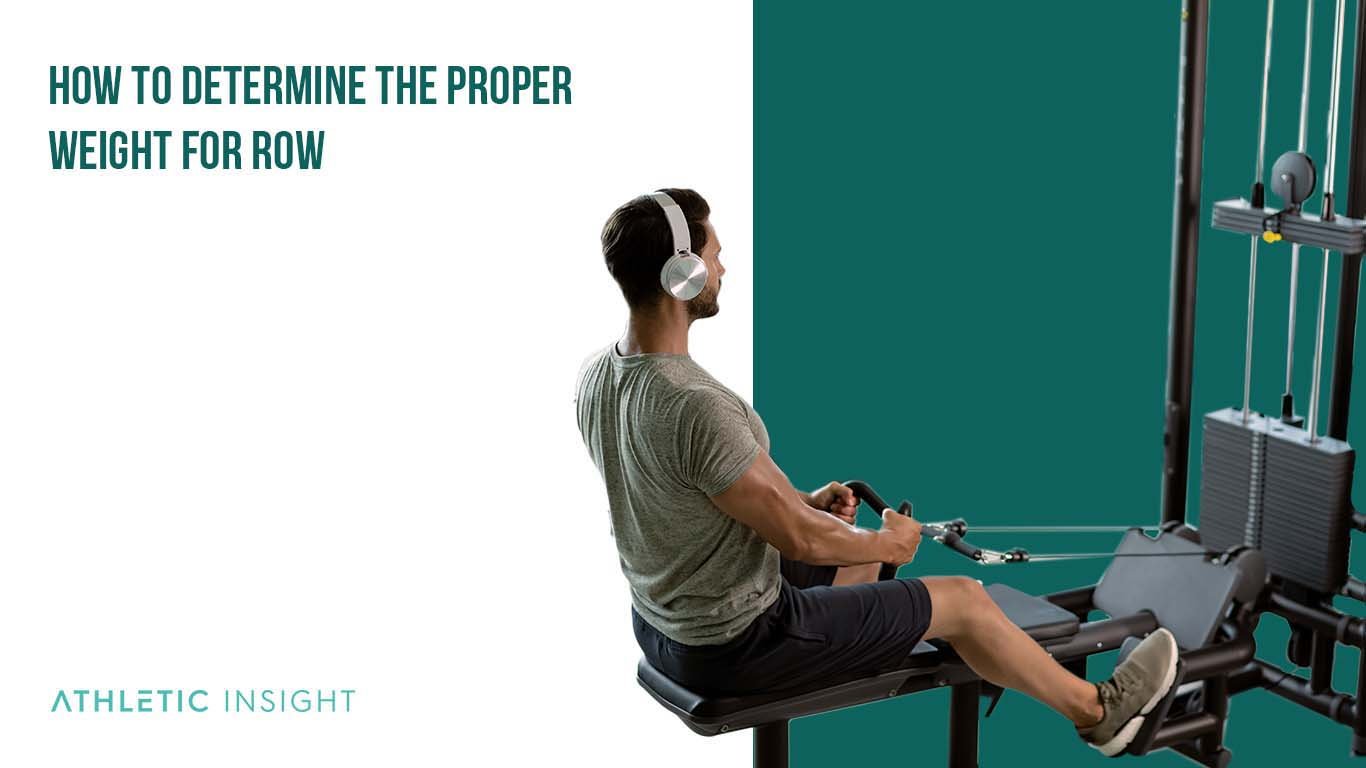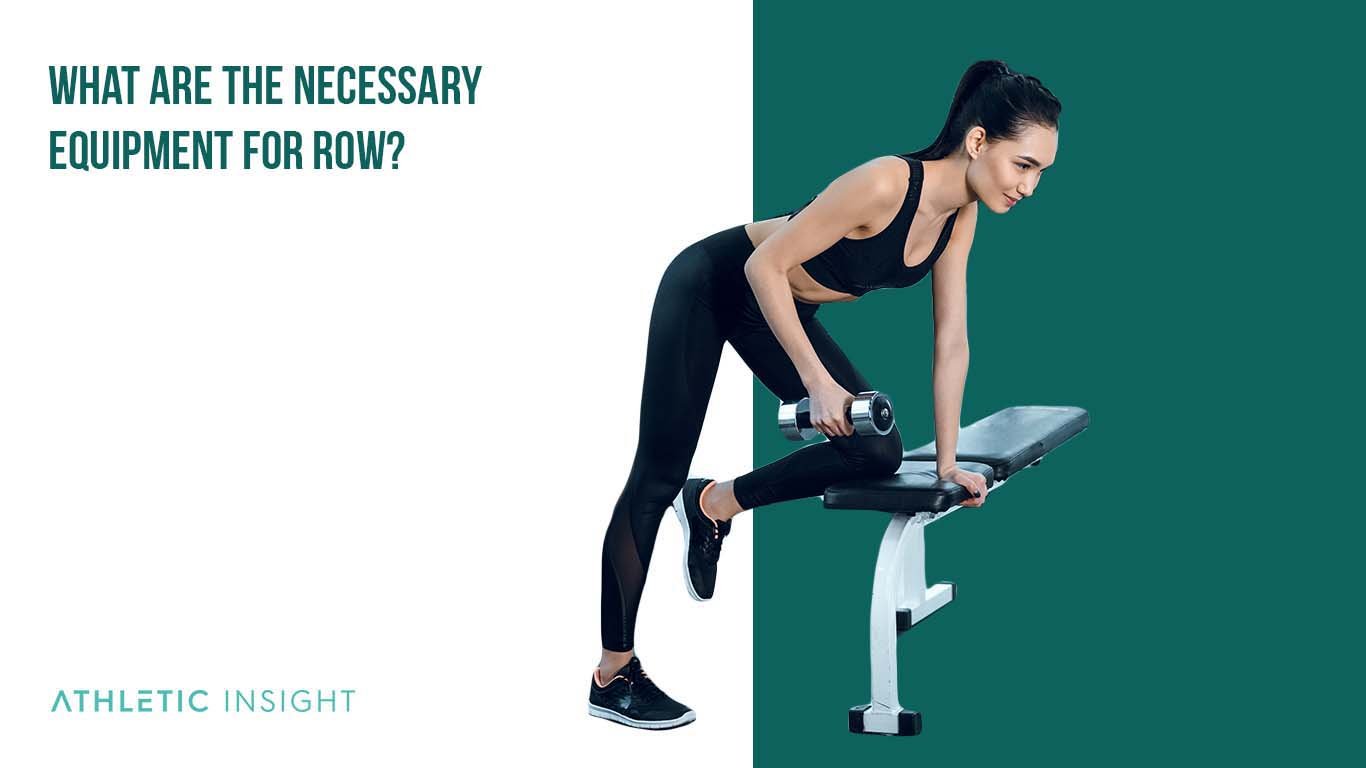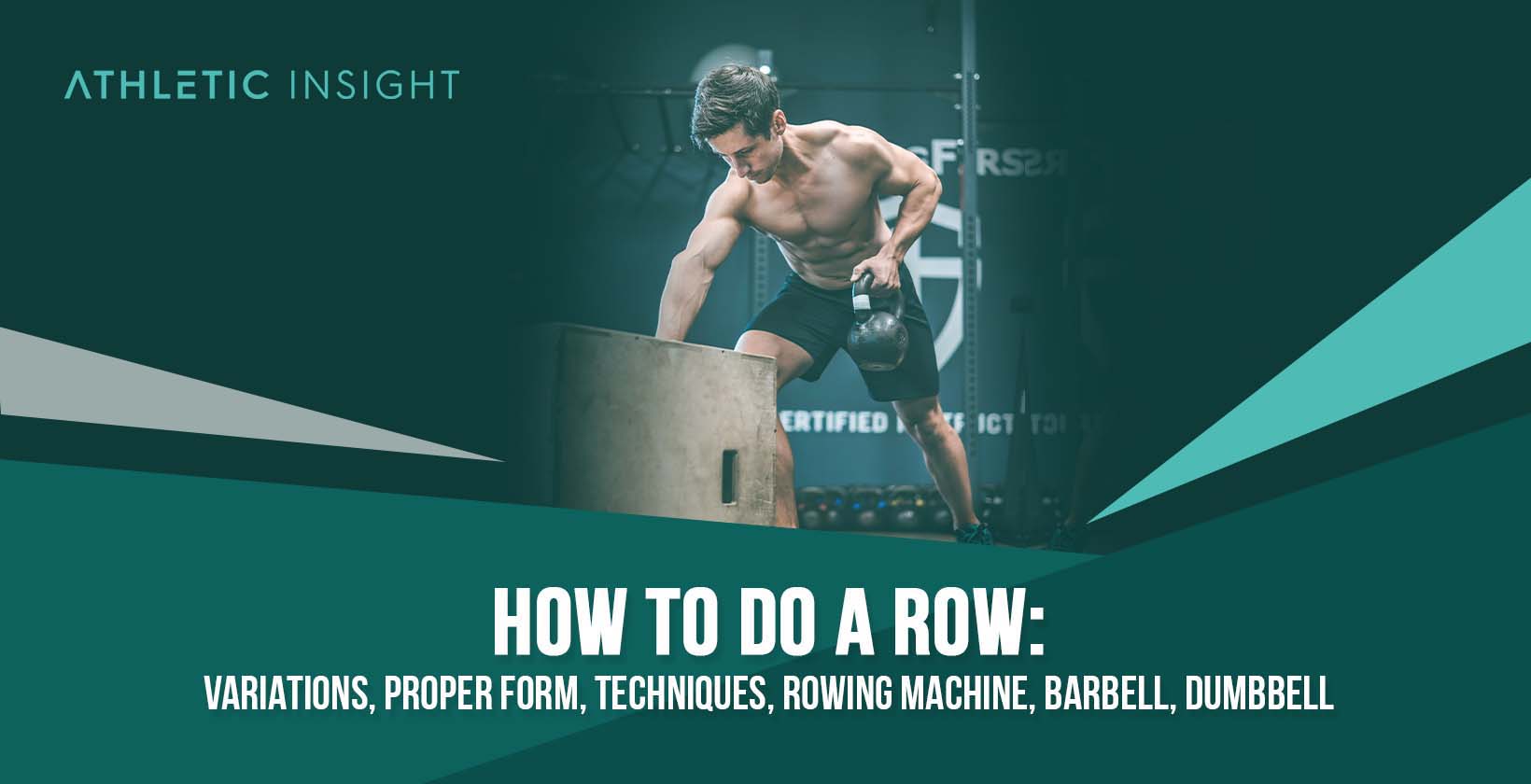A row is an exercise performed by pulling the weight toward the sternum, starting from a straight arm position with the arms perpendicular to the body. It can be performed on a machine or cable station from a seated position, or with free weights with the body bent forward with arms straight toward the floor.
The primary muscles involved in executing a row are the latissimus dorsi (in the mid-back) and the rhomboids (between the shoulder blades). The latissimus dorsi, commonly referred to as “lats”, are large muscles that span the middle of the back and reach around the side to connect just under the armpit. The body has two lats; one on each side of the spine.
Other muscles used as accessories during the row are the trapezius (traps), which are the muscles on either side of the neck that run over the top of the shoulders and connect to the spine, and the biceps, which are the large muscles on the front of the arm between the shoulder and elbow.
How to Perform a Row with Proper Form
When performing a row, proper form is crucial for safety and to get the most benefit from the exercise. A row can be performed with various types of apparatuses: barbells, dumbbells, a cable machine, or a weight machine.
The row can also be performed from various body positions and hand positions. Regardless of the variation of the row exercise, it’s important to keep in mind these four things for proper form. If done correctly, row is an effective workout to include in your back exercise routine.
- The feet should be shoulder-width apart.
- The knees should be slightly bent.
- The back stays straight.
- The neck is in line with the spine.
The instructions listed here refer to a basic row with a barbell. Follow these four steps to perform a barbell row.
- Grab the bar with your hands (palms down). Start with the feet shoulder-width apart, knees slightly bent, standing behind the barbell with the barbell on the floor. Bend at the hips and knees to grab the bar with the palms facing down.
- Hang it straight with your arms. While holding onto the bar and keeping the back straight, raise the torso, straighten the knees to just slightly bent, and lift the bar off the floor. Let the bar hang straight down with the elbows straight. The back should be just above a ninety-degree angle to the floor. This is the starting position of the row exercise.
- Row the weight up to your sternum. Bend the elbows to raise the bar toward the sternum (just below the chest). Keep the elbows close to the body. Do not allow them to flare out. During this part of the exercise, it is helpful to think about squeezing the shoulder blades together while bringing the elbows back.
- Lower it gently back down. Controlling the movement, straighten the elbows to lower the bar back to the starting position.
Proper form is key to dominating the row. The function of the straight back and bent knees is to support the lower back while the exercise is being performed. It is helpful to brace the core with a tightly held breath as the bar is being raised. At the end of each repetition of the row, exhale the breath, and then inhale, brace, and pull the bar again. Another tip is to focus on the path of the elbows and visualize the shoulder blades coming together.
What Are the Benefits of the Row Exercise?
Rows exercise multiple muscle groups and benefit the musculoskeletal and cardiovascular systems of the body. In addition to the physical benefits of the row, several secondary benefits are realized from the exercise.

1. Improves All of the Body
Large muscles are utilized to perform the row. Because of this, the heart rate rises, and smaller muscles surrounding the targeted muscles must activate to stabilize the body. In these ways, the entire body grows stronger from doing the row exercise.
2. Row Movements Improve Body Coordination
Performing a row exercise develops balance and coordination. The body is bent forward while holding and moving heavyweight. It requires concentration to stay balanced and steady throughout the movement. Simultaneously, additional concentration is necessary to remember the elements and form of the exercise to accomplish the movement safely and effectively. There are a lot of moving pieces, so to speak, and practicing them all together improves overall body coordination.
3. Row Exercises Burn Calories
The row exercise incorporates large muscles, which causes the heart rate to increase, and burns calories at a relatively high rate. The heavier the weight being pulled with the row, the more calories will be burned.
4. Row Variations Develop the Heart and Lung Capacity
When stress is placed on the body in the form of lifting heavy weights, the body will adapt to increase the capacity of carrying blood and oxygen to the working muscles. Barbell, dumbbell, cable, and weight-machine rows work the large muscles of the back. The larger the muscles being worked, the more blood and oxygen are needed. The muscles of the heart and lungs will grow stronger to compensate for the additional blood and oxygen requirements.
The rowing machine exercise is a row variation used as a cardiovascular workout. The rowing machine requires the use of the legs, arms, and back to pull a cable toward the body from a flywheel attached to the end of a bar that accommodates a seat sliding back and forth during the rowing motion. All these movements happening together increases the heart rate, causing the heart and lungs to work harder to pump blood and oxygen through the body. This is another form of stress on the body forcing adaptation and development of the heart and lung capacity.
5. Row Variations in Proper Form are Alternatives to the Step Mill and Other Heavy Cardio Movements
The main purpose of the step mill and other forms of cardio exercise is to raise the heart rate and improve the cardiovascular system. Several row variations can accomplish the same goal with potentially less stress on the knee and ankle joints.
The rowing machine provides an excellent cardio workout with minimal pressure on the joints. The seat of the machine glides smoothly along the bar with the continuous movement of the legs and arms. Because all main parts of the body are in motion, the cardiovascular system gets a good workout.
The barbell row variation, if enough weight is used, induces cardio effort. This is caused by heavyweight being pulled by large muscles, which requires increased blood and oxygen from the cardiovascular system. A seated cable row or weight-machine row can also create a cardio workout with adequate repetitions and weight.
6. Row Movements Improve Mood with Good Hormones
As with any moderate to heavy exercise, row movements have a positive impact on the mood. The increase of blood and oxygen moving through the body helps to improve mood by elevating the levels of serotonin and endorphins in the brain.
The row causes a significant increase in blood and oxygen movement because of the large muscles being utilized. Therefore, the row and all its variations can improve the mood. For these same reasons, when done as part of a regular exercise regimen, row movements can also improve sleep, sense of control, and self-esteem.
What Are the Mistakes for Row Form?
Newer lifters or lifters who have not studied the proper form for the row make common mistakes when performing the movement. These row mistakes can lead to the lifter not getting the most benefit out of the exercise at the least, and injury at worst.
1. Arching the Back
The most commonly seen row form mistake is arching the back. While executing a barbell or dumbbell row, arching the back can lead to injury in the lower back. Keeping the back straight helps support the core and decreases the risk of injury.
2. Arm and Shoulder Position
Another mistake many lifters make while performing a barbell or dumbbell row exercise is improper execution of pulling the bar: allowing the elbows to flare outward and shrugging the shoulders. To get the most benefit from the row, it is necessary to focus on keeping the elbows close to the body and shoulders down (away from the ears) while pulling the bar toward the sternum. It is helpful to imagine pulling the shoulder blades together at the top of the lift.
3. Extending the Back Too Far
It is important to practice good row form while performing a cable row as well. A common mistake seen with the cable row is extending the back too far to the rear when pulling the cable toward the body. For a cable row, the back should stop at an upright position while the elbows continue to travel backward to complete the movement. This allows the proper muscles (the rhomboids and lats) to work to complete the exercise versus relying on momentum.
How to Determine the Proper Weight for Row
The amount of weight to use for a row will vary depending on the variation of the exercise. For example, a person might be able to pull more weight doing a seated cable row than a standing bent-over barbell row.

The best way to determine how much weight to use is to start by working with a weight that allows ten to fifteen repetitions with proper form. It should be difficult to execute the last couple of reps. Using this weight, do two to three sets of ten to fifteen reps. When this becomes easier, increase the weight by five to ten percent.
Once the proper start weight has been determined for the row, progression can happen by increasing the weight for ten to fifteen reps to build muscle size, or by decreasing the reps and adding weight at higher increments to increase muscle strength.
What Are the Necessary Equipment for Row?
The row offers multiple variations. Here is a list of row variations and the necessary equipment for each one.

- Barbell Row: a barbell and plate weights
- Dumbbell Row: dumbbells
- Bent-Over Single-Arm Dumbbell Row: dumbbells and a weight bench (if a bench is not available, any sturdy platform at approximately hip height works)
- Seated Cable Row: a cable machine
- Chest-Supported Row: incline bench and dumbbells or a weighted barbell
Is Row a Compound Exercise?
Yes, the row is a compound exercise. A compound exercise is defined as an exercise that works for multiple muscle groups at the same time using multiple joint movements simultaneously. The row meets this definition. It works two primary muscle groups (the lats and rhomboids) and multiple secondary muscles (the biceps and the traps). In addition, other parts of the body are used as stabilizers: the lower back, the abs, the glutes (the muscles in the butt), and the legs. The row also requires the elbows and shoulders to work in tandem to perform the exercise.



